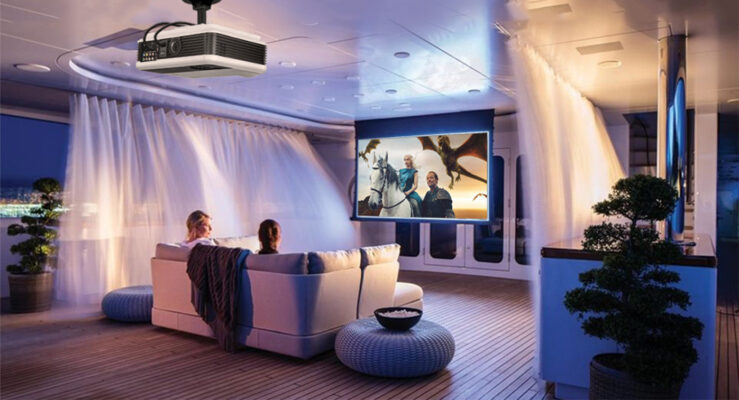If you have come to this article you are looking for information on how to buy a 3D projector.
Let’s focus on what we need to consider to choose it. Not so much to explain how this technology works, because you can find a lot of information on the network about it.
Although you’ll probably already know that the trick is simply to project two images with different angles, one for each eye. It’s what’s known as stereoscopic vision.
That’s why for the correct display we will have to use 3D glasses. Without them, we will see images desynchronized in grayscale with red and blue colors.
Passive or active 3D projector?
Table of Contents
This is the first concept to be clear about in 3D projection. There are two types:
Passive 3D
In a passive 3D projector the projector emits two different images, one on the even lines (left eye), and one on the odd lines (right eye). And polarized 3D glasses filter and fuse the image giving the feeling of three-dimensionality. It is the most widespread for different reasons:
• These are cheaper glasses.
• Less fatigue. That is, they can be used for longer until we start noticing some discomfort in sight or dizziness.
• More comfortable. Since they weigh less by not incorporating additional elements. All that’s needed is polarized crystals.
• For gamers, you can use the so-called Dual play, which allows multiplayer on the same screen.
It also has two clear drawbacks. On the one hand, it will reduce the resolution in half, since it uses the same panel for the two images (left and right eye). And on the other hand, the loss of color. Depending on the filters used by the glasses this loss will be greater or lesser.
Active 3D
The active 3D projection is projecting frames alternately for the left and right eye. At such a fast speed that it is imperceptible. And it will be the 3D glasses that, incorporating their own electronics, fuse the image to achieve this 3D effect.
Its great advantage over passive 3D is image quality. Since you don’t lose resolution when using the entire panel for each image. Like contrast, where you won’t lose quality in colors.
It requires a refresh rate of 120 hz, but we can find them superior for better viewing.
Finally, point out that we can find different systems to get this 3D active. If you want to delve into them in Wikipedia you have a list of them explaining them in more detail: Digital 3D.
Which 3D projector to buy – passive or active?
For home, 3D Active Whether you like it or not, manufacturers have opted for the active technology for their home theater projectors, with its advantages and disadvantages. Therefore, if we want a passive 3D projector we must spend a good amount of money.
If we want to enjoy passive projection we must go to expensive products, like this LG CF3D. On eBay, you can see that it costs no more or less than the cool figure of $12,799.
In the end, the passive projection has not been developed for the home, but for large businesses such as movie theaters or business environments. If we want to have a passive projection in our home we have no choice but to follow the trick below of using two projectors.
Active 3D projector
• For home use, whether you like it or not. Unless you have enough money.
• If you want to enjoy the highest resolution and image quality, without loss of colors.
• And you are aware that the glasses are more expensive.
Passive 3D projector
If you are a company and/or you can make a significant investment, then:
• You will be able to see the projections with many people, where any polarized glasses are worth it. Even the typical red and blue 3D glasses (the traditional anaglyph system). This way we won’t ruin ourselves by buying glasses for everyone.
• And you are aware that resolution and image quality are reduced.
• It is also very useful if you are a lover of video games as a couple because it allows the Dual player as we have seen.
2D to 3D projectors
What these projectors do is convert the 2D image to 3D. Either with one technique or another. In passive mode duplicates the image to separate it slightly and that with the polarized glasses the image is joined. And in the active mode, you will split the image to project it alternately.
It is an increasingly common feature, although the results are not always the most suitable. However, an interesting choice if we don’t want to complicate our lives.
Home 3D projector

If you want to mount a home 3D projector you can get a more expensive remedy than the disease. Since the option for this is to have two projectors if possible identical. Plus a number of extras. Here are the elements you need.
• 2 projectors equal. So that the projected image has the same characteristics in terms of brightness, resolution and contrast.
• 1 silver screen. Silver screen calls, to reflect as much brightness as possible.
• 2 polarizing filters. They will be placed in front of each projector to polarize the image.
• 2 graphics cards or one that is dual.
• 1 computer.
• Polarized glasses. The ones that give you away in any cinema when you watch a 3D movie.
• Software that allows 3D content to be played. In this link, you have up to 10 to choose from.
If you want to know the whole process in detail you can read this article by Edgar Seoane in his blog Efimeroteca where he explains them step by step. As it is an article of 2009, although it is still very useful to follow the process step by step, what has become outdated is the price of the projectors. Which logically back then they were much more expensive.
What is DLP Link sync?
The DLP Link sync is the technology to synchronize our active 3D glasses in an active way that has spread the most. As the name suggests, it’s for DLP technology, and you don’t need annoying cables to sync.
Manufacturers will always recommend using your glasses. And we may notice some improvement. But honestly, for the price difference, many people prefer to opt for generic ones that are compatible.
DLP or LCD technology – which one to choose?
Not that technology is better or worse to project 3D. But we will find many more DLP projectors than LCD, as this technology has bet more on three-dimensional projection. There is a much more suitable technology for these contents: the technology of a led laser projector. That due to its greater efficiency in the emission of light, it causes us to lose less brightness, and therefore we get better images.
It shouldn’t be the decision that leads us to buy a 3D projector, but we will surely find a DLP first with the features that fit what we need. Unless we go to the low end, where the LCD is more widespread.
3D projector vs 3D TV
Without entering into the debate whether a projector is better than a television, no doubt for 3D content will always be better a projector because.
Size matters Size and distance are important for better 3D images. Since they directly affect the perspective and depth of the 3D effect. So it is more feasible to achieve a better effect with a projector than a television.
Other features to consider
It should be borne in mind that when projecting in 3D the demands will be greater than in the 2D projection.
Resolution and contrast
The resolution and contrast the higher the better, as always. That’s why the most common thing to find is the Full HD 3D projector. With a high resolution, it allows us to enjoy higher quality images, where a 3D or lower HD projector can suffer to give us sharp images.
Brightness and 3D display
This technology requires luminous projectors to enjoy it, because due to its operation we will lose brightness along the way. In the face of this, we have two options (or both)
• Opt with a projector with good brightness.
• Acquire a positive gain screen to view 3D. So that we increase the brightness through the screen. In addition, these screens are special for 3D and maintain polarity, avoiding the famous ghosting effect.
Input lag or response time
If in addition to 3D you are also looking to enjoy video games, the fundamental feature for a gamer is input lag. That is, the time it takes in milliseconds from receiving the signal until it projects it. The lower this value, the more we’ll enjoy our video consoles like the PS4, Xbox One, Wii, or Nintendo, without annoying interruptions or delays.
3D glasses
We will need to know the price of 3D glasses in case they come separately and we need to acquire more in the future. If we can, test the compatibility of generic models. And see if we need to connect them wired or not.
As we have already mentioned, in the passive system 3D glasses are cheaper. But it is true that for the active system we can find compatible glasses at a lower price than the official ones of the brand.
Conclusion
We have seen that there are 2 types of 3D projectors, those that use passive technology and those that use active technology. Both with their pros and cons. And the other features that we should take into account. That’s why 3D Full HD projectors are the most sought after for a truly worthwhile 3D viewing.
It is true that other resolutions can perfectly add this technology, but without a doubt, the 3D is more demanding and we will have to take it into account to know how to choose a 3D projector.
And you already have a 3D projector? Have you tried both types of 3D technology? Which one do you think is best? As always, we look forward to the feedback and hope that this article has helped you better understand what features to consider when comparing.
